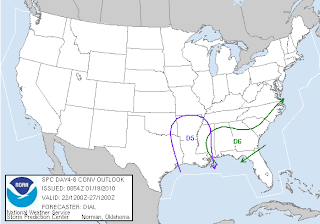Just as the title of this post says, a major winter storm is looking more likely Thursday and Friday for parts of Missouri, Illinois, Kentucky, Tennessee, and Arkansas.
I am looking over new data just in from the night runs of NOAA's global forecast model (GFS). If I were to have to make a snow forecast with the data in hand right now, I would have to say that the heaviest band of snow could be setting up along a line from Poplar Bluff, Missouri and Paducah, Kentucky. Snow will also be north and south of that line. Snow could even be falling from eastern Arkansas in to western Tennessee.
For Cape Girardeau, the precipitation type looks to be all snow. The amount of precipitation is pretty impressive. The GFS pumps out 0.82" of liquid. Even on a 10:1 ratio would bring the snowfall amount to 8.2" of snow. Using a couple of different methods shows that the snow ratio could be between 10:1 to 17:1. The ratio could be going up through the event as the cold air moves in. Overall, tonight's GFS run puts down 11.4" of snow. That's a decent amount. ;)
As I mentioned, it looks like it will be snow south of the area as well. In Jonesboro, Arkansas it looks like it will start out as rain. Then mixing with perhaps an hour or two of freezing rain (1/4"?). Then it changes over to all snow. Quite a bit of snow in Jonesboro too. Perhaps around 8.7".
Here are some of the other model's snowfall amounts.
- Evansville, Indiana: 7.8"
- Farmington, Missouri: 11.1"
- Louisville, Kentucky: 7.9"
- Paducah, Kentucky: 13.5"
- St. Louis, Missouri: 0"
It appears that there will be a pretty sharp cut-off of the snow on the northern edge of the band.
Keep in mind the amounts mentioned above are not forecast amounts. These are numbers coming straight from the computer model. We will continue to be going over the weather data over the next 60-72 hours.
Bottom line... How much snow is still in question. As of right now, it appears that the biggest threat for southeast Missouri, southern Illinois, and western Kentucky will be snow.

















































